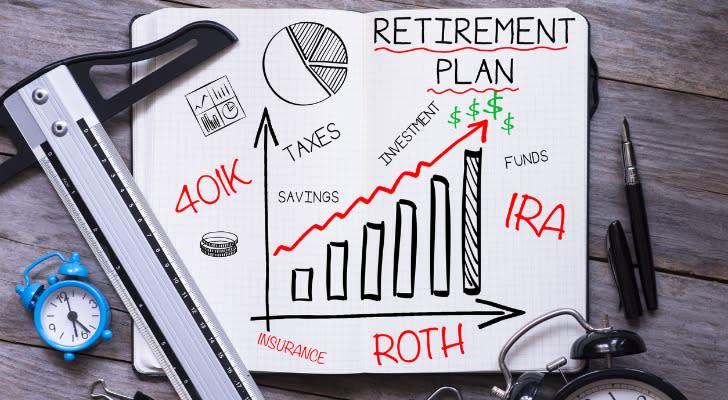If you’re a relatively high earner, you might be locked out of making Roth IRA contributions due to the account’s associated income caps. In that case, you can instead consider a conversion, otherwise known as a "backdoor Roth."
The advantage to doing this is that you will avoid all income taxes on withdrawals from the assets that you convert. The disadvantage is that this comes with a significant up-front tax bill, which is money you could have otherwise invested. However, if your goal is to avoid taxes in retirement, a Roth conversion can be an effective option.
Do you have questions about managing taxes in retirement? Speak with a financial advisor today.
What Is a Backdoor Roth IRA?
A Roth IRA has two restrictions that don't apply to most other tax-advantaged retirement accounts.The first is a low contribution cap. As of 2024, individuals under 50 cannot contribute more than $7,000 per year to a Roth IRA, while that limit is $8,000 per year for those over 50. This is roughly one-third the 401(k) limit, for instance.
Roth IRAs also have income limits to contend with, though. More specifically, you cannot contribute to a Roth IRA if your income exceeds $161,000 for single filers or $240,000 for joint filers. The IRS also steadily reduces your Roth IRA contribution limits at incomes between $146,000 and $161,000 for single taxpayers and $230,000 and $240,000 for joint filers.
For high earners who want to take advantage of a Roth IRA's after-tax perks, these income caps are a problem. A potential solution is a Roth IRA conversion, otherwise known as a "backdoor Roth."
With a conversion, you take assets in an existing pre-tax account, like a traditional IRA or 401(k), and transfer it to a Roth IRA in one lump sum. Since this is not considered a contribution, neither the income limits nor the contribution limits apply. You can convert as many assets as you would like, up to your entire pre-tax portfolio, and there is no limit on how many times you can convert funds.
In the case of this situation, if you are an individual filer, then a $200,000 income puts you above the income caps for Roth contributions. That means a conversion is the only way you can put assets into a Roth IRA. But if you file jointly, you are below the income cap and can choose any combination of contributions and conversions.
Advantages of a Roth Conversion
The benefits to a Roth conversion are already in the question posed for this article. This is one way to avoid/limit paying federal income taxes in retirement. With a Roth IRA, you pay taxes on your contributions, but not your withdrawals or investment growth. Since you will ideally withdraw far more from your portfolio than you will contribute, this should be a significant tax benefit down the road.
Now, it's important to note that a Roth IRA does not protect you from state or local taxes as applicable. That said, those are generally quite small compared to federal income taxes. Even better, since Roth withdrawals do not count as taxable income, they do not apply to the calculation for Social Security benefits taxes.
The result is that converting your retirement account to a Roth IRA will save you most, if not all, of your taxes in retirement. This is as opposed to a pre-tax account, like an IRA or a 401(k), where you do pay income tax on your withdrawals and that money does apply to your Social Security taxable income.Of course, this means you then can’t take advantage of the income deduction benefits that pre-tax accounts offer as you contribute to them.
Disadvantages of a Roth Conversion
A Roth conversion comes with a large up-front tax bill.
When you make a Roth conversion, the value of any assets that you convert are added to your tax bill for that year. So, for example, say you have $2 million in a 401(k) and convert the entire amount. This will save you taxes on your withdrawals, but you will owe income taxes on that $2 million in the tax year you complete the transfer.
This can be a problem since it triggers taxes without the associated cash flow to pay the bill. This is why many people make large Roth conversions in stages, so that they only trigger that tax bill a little at a time. Note you also only pay taxes on that initial conversion. A significant advantage to a Roth conversion is that you will not pay taxes on any future growth in the account.
This is the tradeoff with a Roth IRA. When you invest in a Roth account you pay taxes on the money you put in. This is money you could have invested, setting up the tradeoff of potential growth for guaranteed tax savings.
You’ll likely want to resolve this tension based on tax rates. If you expect that your tax rate in retirement will be higher than your current rate, or if you don't think you would invest the savings of a pre-tax account, then a Roth IRA could be worthwhile. If you expect to pay a lower tax rate in retirement compared with right now, then a pre-tax account could save you more money in the long run.
Finally, any Roth IRA is subject to the IRS' pro-rata rule. This rule applies when you have both a pre-tax IRA and a post-tax Roth IRA. In that case you must take all withdrawals proportionally from both accounts. For example, say that you have $1 million in an IRA and $500,000 in a Roth IRA (a 2/1 ratio). If you withdraw $60,000 in a given year, you would have to take $40,000 from your traditional IRA and $20,000 from your Roth IRA (a 2/1 ratio). This can limit your flexibility when it comes to using this account.
How to Set Up a Backdoor Roth
Setting up a Roth conversion depends on exactly how you would like to structure your tax payments, and on when you will need the money. When you make a Roth conversion you must leave the money in the account for at least five years, so plan for short-term cash flow in the meantime.
To set this up, you will need a pre-tax account like an IRA or a 401(k).You can then move your money a few different ways.
The simplest option is a one-time, lump-sum transfer. In this case you move your entire portfolio into a Roth IRA. This can let you maximize your tax-free returns, but it can come with a steep up-front tax bill.
Another option is to set up staged transfers. In this case you would convert your portfolio a portion at a time over multiple tax years. This lets you manage the tax bill triggered by each year's conversion(s), but it mitigates your tax-free returns.
Finally, you can make ongoing or automatic conversions. You can do this with an IRA or with 401(k) plans that permit the option. In this case, you contribute money to a pre-tax account and leave it in place for any required holding period. Then transfer the account's assets to a Roth IRA, or you can set up an automatic transfer if your account allows this.
Bottom Line
As an individual making $200,000 per year, you cannot contribute to a Roth IRA if you’re single, but can if you’re married and file jointly. However you can convert funds from a pre-tax account into a Roth IRA through a process known as a "backdoor Roth." This will let you minimize federal income taxes in retirement at the cost of a large tax bill in the immediate.
Roth IRA Tips
A financial advisor can help you build a comprehensive retirement plan. Finding a financial advisor doesn't have to be hard. SmartAsset's free tool matches you with up to three vetted financial advisors who serve your area, and you can have a free introductory call with your advisor matches to decide which one you feel is right for you. If you're ready to find an advisor who can help you achieve your financial goals, get started now.
A Roth IRA might seem like an easy choice, and it's true that this program's tax savings are incredible. But that doesn't make this an automatic choice, so before converting any assets make sure that a Roth IRA is a good choice for you.
Photo credit: ©iStock.com/adrian825, ©iStock.com/momcilog, ©iStock.com/Filmstax
The post I Will Make $200k This Year. How Can I Use a Backdoor Roth to Avoid Taxes in Retirement? appeared first on SmartReads by SmartAsset.


